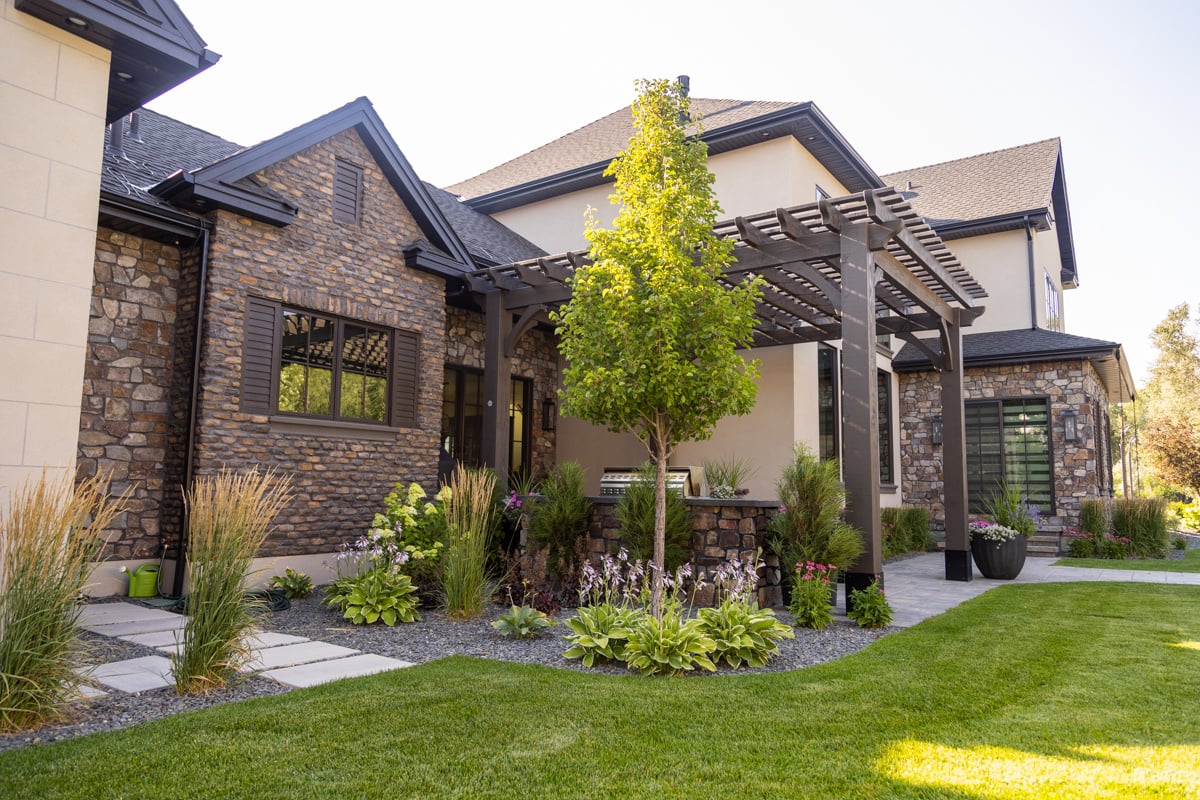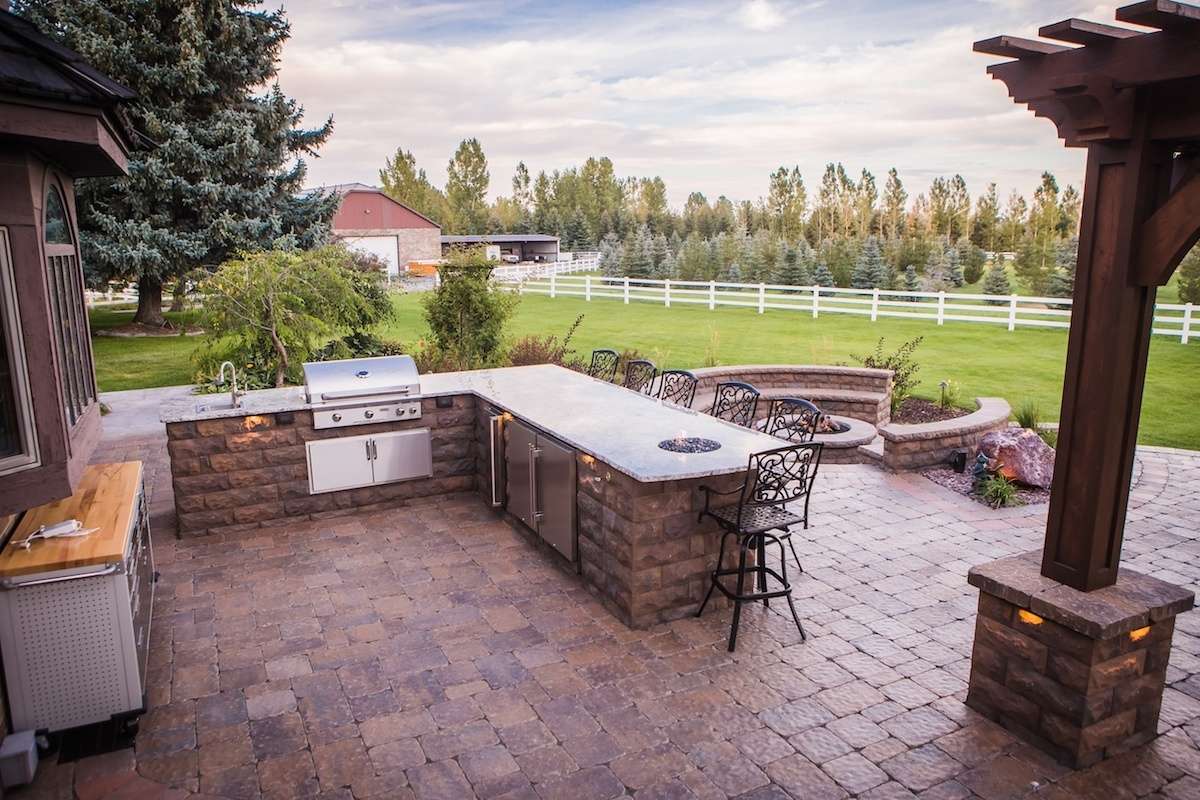
.jpg)
The Best Evergreen & Idaho Native Trees for Privacy & Windbreaks
If you can't enjoy time around your Idaho backyard fire pit without worrying that those embers might go flying towards your guests - or worse, your home - it's time to consider some ways to break that stiff mountain wind.
It gets windy around here.
Jump to Section
- First, How Do Windbreaks Work?
- What Are the Best Trees for Windbreaks?
- You Have Your Windbreak Trees: Now What?
- Group Trees for an Appealing Windbreak — Don’t Just Line Them Up
- Beyond Windbreaks: The Best Evergreens for Privacy
- The Best Trees for Windbreaks: How to Keep Them Thriving
- Looking for the Best Trees for Windbreaks and Privacy? Trust Outback
A natural windbreak of pretty trees and shrubs will calm the wind that whips through your property, which can actually reduce your energy bills and make for much better hair days.
What are the best Idaho trees for wind breaks? Colorado Blue Spruce. Aspen. Cottonwoods. Austrian Pine. Maples. Honeylocust.
Outback landscape designer Kim Rubert shares her strategy for installing windbreaks and why these sturdy landscape elements can be a beautiful part of your Idaho landscape design.
Let’s learn more about the best trees for windbreaks and privacy screening.
First, How Do Windbreaks Work?Windbreaks are groups of trees that provide a screen or protection from the wind, as well as from blowing sand or dirt. When the wind hits, a windbreak lifts the wind up and over, protecting your property.
Windbreaks can also save you money on your energy bills by filtering, deflecting and slowing wind before it reaches your home. The result is an insulated area that provides a more comfortable environment—inside and out.
What Are the Best Trees for Windbreaks?
“We like to do a variety of evergreen and deciduous trees to make a windbreak look more natural,” Rubert says.
She has a whole list of favorites for landscape design in Idaho Falls:
- Colorado Blue Spruce
- Cottonwood
- Aspen
- Austrian Pine
- Maple
- Honeylocust
- Crabapples
“If you’re using deciduous trees, you can also put larger shrubs like lilacs or burning bush underneath to provide better wind blocking,” Rubert says.

Use Idaho native trees in your windbreak design, and you do more than block the whipping wind. Native trees are low maintenance, require less water and fertilizer, and provide essential food, shelter, and nesting sites for native insects, birds, and other animals.
What are the best Idaho native trees for windbreaks? Western Hemlock, Colorado Blue Spruce and Douglas Fir all make the list.
You Have Your Windbreak Trees: Now What?
Maybe you’re picturing a straight row of sturdy trees. That should block the wind. But there’s more to an excellent windbreak than that - it involves science, structure and creative landscape design.
As you drive around Idaho Falls, you might notice double rows of trees planted as windbreaks — a row of cottonwoods or aspens as a windbreak with a row of spruce trees planted behind it.
Cottonwoods and aspens grow fast but have a short lifespan and tend to break more easily after a period of time. So landscaping crews often supplement these deciduous trees with a second row of Colorado spruce, which grows more slowly.
.jpg?width=1422&height=948&name=lawn%20walkway%20trees%20groundcover%20planting%20beds%20perennials%20(1).jpg)
Once the cottonwoods and aspens die out in 20 to 30 years, the spruce will provide that sturdy, solid windbreak. The two rows serve different purposes: the first offers instant wind protection, while the second is for long-term use. Together, they’re often the best trees for windbreaks.
“This strategy with the rows has certainly been used here,” Rubert says. “Sometimes you'll see it around fields or along freeways.”
But she doesn’t recommend the double row strategy for an appealing residential design.
“We like to stay away from just doing straight rows of anything,” she says. “When creating a wind block, we’ll try to do more natural groupings or berms.”
(If you don’t have your landscape dictionary handy, a quick refresher: A berm is a raised mound of earth that adds height and interest to flat areas, and works to screen views.
Group Trees for an Appealing Windbreak — Don’t Just Line Them Up
“We never want to do just a wall of trees,” Rubert says, “so we’ll do groupings of odd numbers — for example, three spruce, five deciduous trees, and understory shrubs as needed.”
When you design a windbreak this way, with natural groupings of a mix of the best trees for windbreaks, they become part of an attractive landscape, Rubert says. Sure, they’ll work hard to block the wind, but they also just plain look great.

“A lot of designs we do will have natural windbreaks,” she says, “because trees are a priceless part of a design.”
Windbreaks don’t need to be planted around your entire property to block the wind. Rubert incorporates them to block wind where you spend a lot of time in your yard, planting them strategically to make a difference in your Idaho Falls or Jackson Hole landscape design.
Beyond Windbreaks: The Best Evergreens for Privacy
Windbreak trees do more than block the wind. They can reduce unwelcome sounds, such as highway noise and rush-hour traffic.
Windbreaks can also control the spread of weeds from seeds that blow in the wind, as well as that pesky pollen that might make you sneeze in the spring.
And strategically planted trees are great for privacy, too.

Maybe you love living in the city, but the street noise interferes with your backyard chill. Or you want to enjoy your morning waffles on the patio in your robe without your neighbor raising an eyebrow.
What about evergreen trees for screening?
Evergreens are great for reducing noise and providing privacy year-round. Bonus: they also act as a snow screen. Douglas fir is a popular choice for privacy screening.
Other evergreen trees for screening include ‘Green Giant’ Arborvitae, a vigorous, fast-growing evergreen that grows as much as 3 feet per year. Its rich green foliage is wind-resistant once established, and it can withstand heavy ice or snow.
Some deciduous trees are among the best trees for privacy, too. A couple Rubert's favorites:
Swedish Aspen
Hardy and boasting pretty fall color, Swedish Aspen has rounded leaves that rustle in the breeze, adding a soothing sound to enjoy from your patio.

It’s narrow and great for small spaces if you need that. It tolerates drought and poor soil and needs minimal pruning. Unlike other aspen varieties, this one produces no annoying fluff to clog your window screens.
Canadian Hemlock
Canadian Hemlock is among the best trees for privacy if you have picky conditions. It thrives in the cold, doesn’t mind poor soil, and is happy in sun or shade.
%20CC.jpg?width=3456&height=2592&name=Canadian%20Hemlock%20(Tsuga%20canadensis)%20CC.jpg)
Plant a few of them together, and they’ll grow into a dense privacy hedge that also offers protective winter cover for birds and small furry critters.
Which trees are fast-growing for privacy? If you're in a hurry to create backyard privacy, opt for Hemlock, Serviceberry, ‘Green Giant’ Arborvitae, or ‘Skyrocket’ Juniper, all fast growers.
The Best Trees for Windbreaks: How to Keep Them Thriving
Once your windscreen or privacy screen trees are in place, keep them thriving with regular plant health care, including:
Tree & Shrub Fertilization
Your windbreak trees are working hard out there. Be sure to replace the nutrients they’re depleting.
When your trees struggle to get the essential nutrients they need, they get weak. That makes them more susceptible to diseases and damaging insects.
Even the best trees for windbreaks won’t thrive if they’re hungry. Weak trees won’t grow as tall or as full as they could, and you want windbreak trees to be at their best. That means regular fertilizing throughout the year.
Do They Need Deep Root Fertilization?
Maybe you’ve noticed your windbreak trees aren’t looking so great. Are their leaves smaller than normal? Are the leaves yellowing, or do they have dead spots? Are the branches thinning? Does growth seem to be slowing down?
They might need deep-root fertilization to boost nutrition.
Deep-root tree fertilization injects nutrients directly into the soil, rather than spreading fertilizer on the surface.

By injecting fertilizer under high pressure, the nutrients can reach the deepest tree roots quickly, feeding your tree from the roots up.
Over time, the nutrients move to the rest of your tree, making it healthier and more vibrant.
Pruning Windbreak Trees
Windbreak trees don't need any special pruning, Rubert says, but routine pruning is crucial for good tree health.
“Just remove the dead and crossing branches,” she says, “as well as other good pruning practices.”
That includes pruning at the right time of year.
Here in Idaho Falls, winter is the best time for pruning trees and shrubs, including windbreaks.
In winter, your trees and shrubs are dormant. You’ll do less damage now when you prune than when you clip away in their active growing months.
Those fresh pruning cuts heal faster during the dormant season, too— and are less likely to attract disease-carrying insects.
With no leaves to obscure your view, you get a great look at each branch, so you can really see the structure and health of the tree or shrub. Now you can easily spot any dead, diseased, or crossing branches that need to be pruned.
Looking for the Best Trees for Windbreaks and Privacy? Trust Outback
Sure, you could plant a sturdy row of trees and call it good, but that won’t do your landscaping any favors.
Rubert combines her horticulture expertise and creative design skills to create windbreaks and privacy screens that don’t just work hard—they look beautiful.
.jpg?width=1334&height=889&name=lawn%20horizon%20mountains%20trees%20nice%20(1).jpg)
Outback’s team can assess your property, identify the best locations for windbreaks, and provide a planting and maintenance plan.
Ready for skilled and innovative landscape design in Idaho Falls and Jackson Hole, WY? Outback Landscape serves residential and commercial properties in Idaho Falls, Rexburg, and Pocatello, Idaho, as well as Bonneville, Madison, and Bannock counties, and Jackson Hole, WY. Call us at 208-656-3220, or contact us to schedule an on-site consultation. We’d love to hear from you.
Image Sources | Swedish Aspen, Canadian Hemlock
.jpg?width=480&name=Chase%20Coates%20Team%20Portrait%202%20(2).jpg)
Chase Coates
Chase Coates is the owner of Outback Landscape in Idaho Falls, Idaho.


Brick Pavers vs Stamped Concrete: Pros, Cons, and Costs
.jpg)



